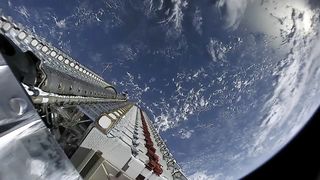SpaceX's internet-satellite megaconstellation appears to be off to a good start in low-Earth orbit.
The first 60 members of the company's Starlink network launched last night (May 23) atop a Falcon 9 rocket. The satellites deployed smoothly about an hour after liftoff, and they came online shortly thereafter, SpaceX founder and CEO Elon Musk announced via Twitter last night.
Musk gave us another update this afternoon (May 24), tweeting "So far, so good" in response to a follower's question about Starlink's status.
"Krypton thrusters operative, satellites initiating orbit raise every 90 mins," he added in another tweet a bit later. (The satellites deployed at an altitude of 273 miles, or 440 kilometers, and are making their own way to their operational altitude of 342 miles, or 550 km).
Related: SpaceX's 1st Starlink Satellite Megaconstellation Launch in Photos!

Some lucky skywatchers have even captured glimpses of the Starlink train passing overhead.
"VIDEO! Prepare to be mind-blown! The train of @SpaceX #Starlink satellites passing over Leiden, the Netherlands, some 25 minutes ago. Camera: WATEC 902H with Canon FD 1.8/50 mm lens. I was shouting when they entered FOV! @elonmusk," satellite tracker Marco Langbroek wrote via Twitter today.
Get the Space.com Newsletter
Breaking space news, the latest updates on rocket launches, skywatching events and more!
VIDEO! Prepare to be mind-blown!The train of @SpaceX #Starlink satellites passing over Leiden, the Netherlands, some 25 minutes ago. Camera: WATEC 902H with Canon FD 1.8/50 mm lens. I was shouting when they entered FOV!@elonmusk https://t.co/xChLDH32ukMay 24, 2019
Starlink is designed to provide affordable internet access to people around the world. Last night's launch was the first of many for the project; about 400 satellites are needed for "minor" coverage and 800 for "moderate" coverage, Musk has said.
And the constellation could end up being truly enormous. The Federal Communications Commission has given SpaceX permission to launch nearly 12,000 Starlink satellites. (For perspective: There are only about 2,000 operational spacecraft in Earth orbit today.)
Krypton thrusters operative, satellites initiating orbit raise every 90 minsMay 25, 2019
If everything goes well, Starlink could end up generating $30 billion to $50 billion in revenue every year for SpaceX, Musk said earlier this month in a call with reporters. That's far more than the company's launch revenue, which tops out around $3 billion annually.
SpaceX has launched a website for the constellation, Starlink.com, to explain its massive scale.
SpaceX hopes to use this money to develop and build its Mars-colonizing transportation system, which consists of a 100-person spaceship called Starship and a giant rocket known as Super Heavy. This reusable duo could start flying people to the Red Planet as early as the mid-2020s, Musk has said.
But Starlink will have to overcome some competition to be successful. Several other companies — notably, OneWeb, Telesat and Amazon — plan to launch big broadband constellations to low-Earth orbit as well.
- See the Evolution of SpaceX's Rockets in Pictures
- Elon Musk: Private Space Entrepreneur
- In Photos: SpaceX's 1st Falcon Heavy Rocket Test Launch Success!
Mike Wall's book about the search for alien life, "Out There" (Grand Central Publishing, 2018; illustrated by Karl Tate), is out now. Follow him on Twitter @michaeldwall. Follow us on Twitter @Spacedotcom or Facebook.
Join our Space Forums to keep talking space on the latest missions, night sky and more! And if you have a news tip, correction or comment, let us know at: community@space.com.

Michael Wall is a Senior Space Writer with Space.com and joined the team in 2010. He primarily covers exoplanets, spaceflight and military space, but has been known to dabble in the space art beat. His book about the search for alien life, "Out There," was published on Nov. 13, 2018. Before becoming a science writer, Michael worked as a herpetologist and wildlife biologist. He has a Ph.D. in evolutionary biology from the University of Sydney, Australia, a bachelor's degree from the University of Arizona, and a graduate certificate in science writing from the University of California, Santa Cruz. To find out what his latest project is, you can follow Michael on Twitter.